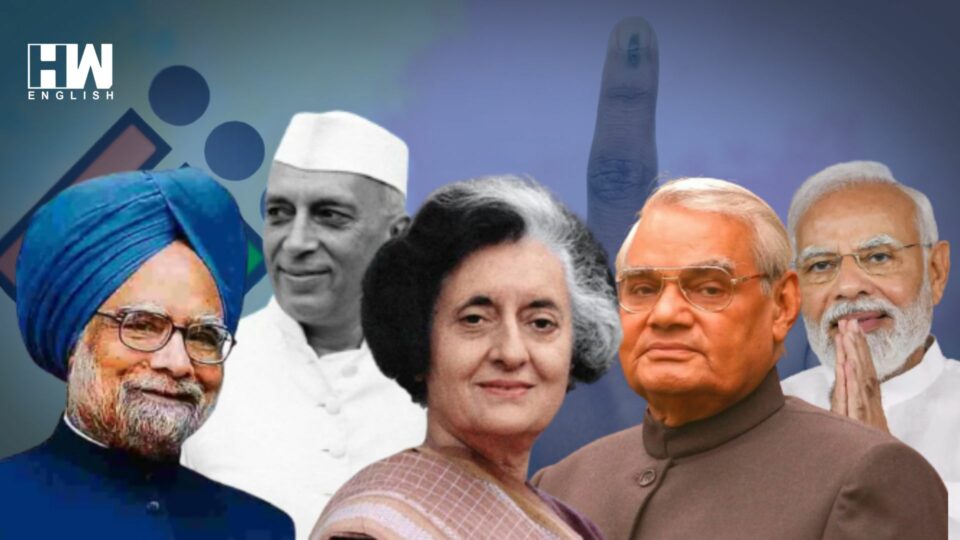One country, eight union territories, 28 states, and a staggering 543 constituencies – the fate of it all comes down to June 4th as India eagerly awaits the results of its 18th Lok Sabha elections for 2024. Will the Bharatiya Janata Party (BJP) see a comeback as Prime Minister Narendra Modi bids for a third term, or will the united INDIA alliance lead toward a glorious victory? All will be revealed tomorrow.
As the nation holds its breath in anticipation, let’s dive back into the rich history of India’s Lok Sabha elections since independence in 1947.
• 1951-52: The Congress party, led by Jawaharlal Nehru, won the first election, which was carried out between 1951 and 1952. Nehru became the country’s first Prime Minister, with the Congress securing 364 out of 489 seats and about 45% of the vote. The Communist Party of India (CPI) and the Socialist Party (SP) emerged as the second and third-largest parties.
• 1957: Congress, again led by Nehru, retained power, winning 371 out of 494 seats and 47.8% of the vote. The CPI and the Praja Socialist Party (PSP) were the second and third-largest parties.
• 1962: Under Nehru’s leadership, Congress secured 361 out of 494 seats and 44.7% of the vote, with the CPI and the Swatantra Party taking the second and third spots.
• 1967: Indira Gandhi took over the reins of the Congress party and led them to victory, winning 283 out of 520 seats and 40.8% of the vote. The Swatantra Party and the Bharatiya Jana Sangh (BJS), the precursor to the BJP, were the second and third-largest parties.
• 1971: Indira Gandhi’s Congress party consolidated its hold, winning 352 out of 518 seats and 43.7% of the vote. The Communist Party of India (Marxist) (CPM) and the CPI emerged as the second and third-largest parties.
• 1977: In a historic upset, the Bharatiya Lok Dal (BLD) defeated the Congress party, winning 295 out of 542 seats and 41.3% of the vote. This was the first time the Congress lost a national election after Indira Gandhi’s controversial imposition and subsequent lifting of a state of national emergency.
• 1980: Congress, led by Indira Gandhi, regained power, winning 353 out of 529 seats and 42.7% of the vote. The Janata Party (Secular) and the CPM were the second and third-largest parties.
• 1984: In the aftermath of Indira Gandhi’s assassination, her son Rajiv Gandhi led the Congress party to a sweeping victory, securing 404 out of 514 seats and 49.1% of the vote – the largest mandate ever received by any government in independent India. The Telugu Desam Party (TDP) and the CPM were the second and third-largest parties.
• 1989: No party achieved a clear majority, with the Congress emerging as the largest party under Rajiv Gandhi, winning 197 out of 529 seats and 39.5% of the vote. The Janata Dal (JD) and the BJP were the second and third-largest parties, eventually forming a coalition government.
• 1991: The Congress, led by P.V. Narasimha Rao, was the largest party, winning 232 out of 521 seats and 36.3% of the vote. The BJP and the JD were the second and third-largest parties.
• 1996: The BJP, led by Atal Bihari Vajpayee, emerged as the largest party, winning 161 out of 543 seats and 20.3% of the vote. The Congress and the JD were the second and third-largest parties.
• 1998: The BJP, again led by Vajpayee, retained its position as the largest party, winning 182 out of 543 seats and 25.6% of the vote. The National Democratic Alliance (NDA) was formed three months after polling, with the Congress and the CPM being the second and third-largest parties.
• 1999: Vajpayee’s BJP remained the largest party, winning 182 out of 543 seats and 23.8% of the vote. The Congress and the CPM were the second and third-largest parties.
• 2004: The Congress, led by Sonia Gandhi, emerged as the largest party, winning 145 out of 543 seats and 26.5% of the vote. The United Progressive Alliance (UPA) was formed after the election, with the BJP and the CPM being the second and third-largest parties.
• 2009: The Congress, led by Manmohan Singh, retained power as the largest party, winning 206 out of 543 seats and 28.6% of the vote. The BJP and the Samajwadi Party were the second and third-largest parties.
• 2014: The BJP, led by Narendra Modi, achieved a resounding victory, winning 282 out of 543 seats and 31.3% of the vote. The Congress and the All India Anna Dravida Munnetra Kazhagam (AIADMK) were the second and third-largest parties.
• 2019: Modi’s BJP consolidated its hold, winning 303 out of 543 seats and 38% of the vote. The Congress and the Dravida Munnetra Kazhagam (DMK) were the second and third-largest parties.
As the nation eagerly awaits the results of the 2024 Lok Sabha elections, the stakes have never been higher. Will Modi’s BJP defy the odds and secure a third consecutive term, or will the INDIA alliance usher in a new era of governance? Only time will tell, but one thing is certain – the people of India have spoken, and their voice will echo through the halls of democracy.
Also Read: EC Denies Jairam Ramesh’s Request For Time Explanation Against Shah
As an independent media platform, we do not take advertisements from governments and corporate houses. It is you, our readers, who have supported us on our journey to do honest and unbiased journalism. Please contribute, so that we can continue to do the same in future.

